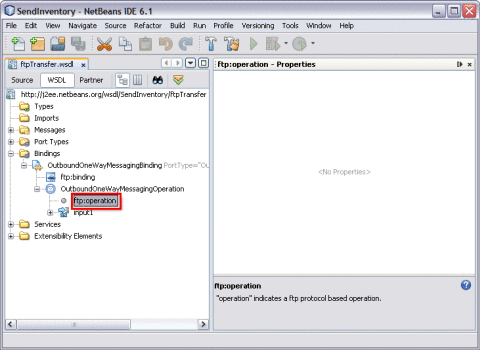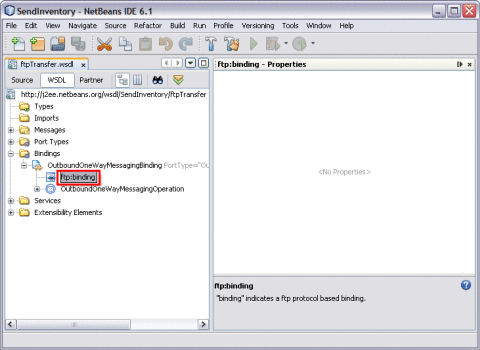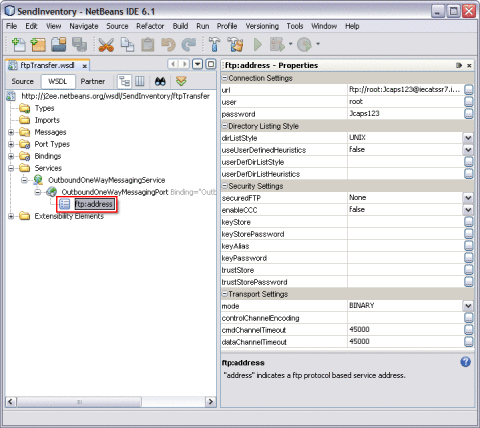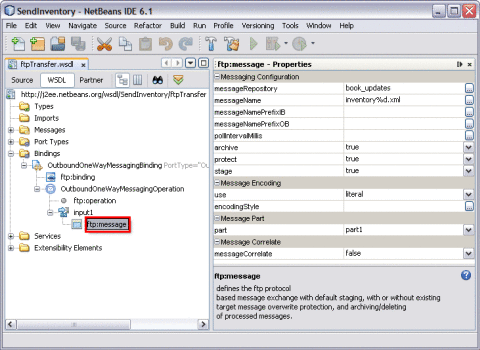Runtime Configuration
The runtime configuration for FTP Binding Component is as follows:
-
FTP Operation Element (<ftp:operation>)
-
FTP Binding Element (<ftp:binding>)
-
FTP Transfer Element (<ftp:transfer>)
-
FTP Address Element (<ftp:address>)
-
FTP Message Element (<ftp:message>)
FTP Operation Element (<ftp:operation>)
FTP operation indicates a ftp protocol based operation.

FTP Binding Element (<ftp:binding>)
FTP binding indicates a ftp protocol based binding.

FTP Transfer Element (<ftp:transfer>)
The FTP transfer element extends the WSDL binding element to allow you to specify a message transfer from a sender and a receiver's perspective. Typical reasons to use the FTP transfer element include the following:
-
Override the default message repository locations with custom settings
-
Use pattern matching when transferring files
-
Append the message to the target file
 Table 6 FTP Transfer Element
Table 6 FTP Transfer Element|
Attribute Name |
Description |
|---|---|
|
sendTo |
The FTP PUT target for the message. Specify the target using either a relative path or absolute path form:
For more information, see Table 7. |
|
append |
Specifies whether the message is appended to the target file specified by the sendTo property.
Default value: false |
|
sendToHasPatterns |
Specifies if the target specified by the sendTo property contains patterns in its path components and/or file name. If sendToHasPatterns is false, then the target path and filename are literals. Default value: false For more information, see Table 7. |
|
receiveFrom |
The target to poll for FTP GET messages. Specify the target using either a relative path or absolute path form:
For more information, see Table 7. |
|
receiveFromHasRegexs |
Specifies if the target specified by the receiveFrom property contains regular expressions in its path components and/or file name. If receiveFromHasRegexs is false, then the target path and filename are literals. Default value: false |
|
pollIntervalMillis |
The interval (in milliseconds) for an inbound component (receiver) to poll the target. Default value: 5000 |
|
preSendCommand |
Specifies the operation to perform before sending an FTP message. Values can be NONE, COPY, or RENAME Default value: NONE |
|
preSendLocation |
The destination file to be used with the preSendCommand. Specify the file using either a relative path or absolute path:
patterN and filename can be literal or a pattern, depending on the value of the preSendLocationHasPatterns property. For more information, see Table 7. |
|
preSendLocationHasPatterns |
Specifies if the file specified by the preSendLocation property contains patterns in its path components and/or file name. If preSendLocationHasPatterns is false, then the target path and filename are literals. Default value: false |
|
postSendCommand |
Specifies the operation to perform after sending a message. The value can be either NONE or RENAME. Default value: NONE |
|
postSendLocation |
The destination file for the postSendCommand. Specify the file using either a relative path or absolute path:
patterN and filename can be literal or a pattern, depending on the value of the postSendLocationHasPatterns property. For more information, see Table 7. |
|
preReceiveCommand |
Specifies the operation to perform before receiving an FTP message. Values can be either NONE, COPY, RENAME Default value: NONE |
|
preReceiveLocation |
The destination file to be used with the preReceiveCommand. Specify the file using either a relative path or absolute path:
patterN and filename can be literal or a pattern, depending on the value of the preReceiveLocationHasPatterns property. For more information, see Table 7. |
|
preReceiveLocationHasPatterns |
Specifies if the file specified by the preReceiveLocation property contains patterns in its path components and/or file name. If preReceiveLocationHasPatterns is false, then the target path and filename are literals. Default value: false |
|
postReceiveCommand |
Specifies the operation to perform after receiving an FTP message. Values can be either NONE, DELETE, or RENAME. Default value: NONE |
|
postReceiveLocation |
The destination file to be used with the preReceiveCommand. Specify the file using either a relative path or absolute path:
patterN and filename can be literal or a pattern, depending on the value of the preReceiveLocationHasPatterns property. For more information, see Table 7. |
|
postReceiveLocationHasPatterns |
Specifies if the file specified by the preReceiveLocation property contains patterns in its path components and/or file name. If preReceiveLocationHasPatterns is false, then the target path and filename are literals. Default value: false |
|
senderUsePassive |
Specifies whether to use passive FTP on the sender side. Default value: true |
|
ReceiverUsePassive |
Specifies whether to use passive FTP on the receiver side. Default value: true |
|
use |
Specifies whether a message (or message part) is literal or encoded. If encoded is specified, then you must also specify the encoder using the encodingStyle property. Default value: Literal |
|
encodingStyle |
Specifies the encoding type associated with the message (or message part). This also defines the encoder type responsible to process the encoded data. There is no default value: ud1encoder-1.0 |
|
part |
References which part of the message described in the abstract WSDL to use for the message. It is Part1. If the part property is not specified, then the first part listed in the abstract WSDL is used. |
|
messageCorrelate |
Specifies whether UUID tagging-based message correlation is enabled. If true, then the message correlation is enabled. Otherwise, message correlation is not enabled. Default value: false |
Pattern Matching
You can use pattern matching to generate filenames for messages and to retrieve messages according to the generated filename patterns. The following message properties make use of pattern matching:
-
sendTo
-
sendToHasPatterns
-
receiveFrom
-
receiveFromHasPatterns
-
preSendLocation
-
preSendLocationHasPatterns
-
postSendLocation
-
postSendLocationHasPatterns
-
preReceiveLocation
-
preReceiveLocationHasPatterns
-
postReceiveLocation
-
postReceiveLocationHasPatterns
The % character precedes a character that indicates the pattern to be expanded.
For example, %y%y%y%y expands to 2007
Use an additional % as an escape character to print the % character as a literal.
For example, %%y%%y%%y%%y expands to %y%y%y%y
The table describes various Pattern Matching for FTP Binding Component Message Transfer Targets
Table 7 Pattern Matching for FTP Binding Component Message Transfer Targets|
Pattern Type |
Description |
|---|---|
|
Timestamp |
The FTP Binding Component specifies a timestamp using the simple Java date/time formats: %[GyMdhHmsSEDFwWakKz] For example, abc%y%y%y%y expands to abc2007 For more information, see Table 4. |
|
Directory and Filename Replacement |
%p/%f Typically used to specify the directory name and filename for pre-transfer and post-transfer operations. For example, if sendTo specifies my_in_box/invoice.dat, then the following pattern: %p_backup/%f.bak Expands to: my_in_box_backup/invoice.dat.bak |
|
UUID |
%u Inserts a UUID value compliant with Java 1.5 UUID. |
|
Sequence Numbering |
%0, %1, ... , %9 Inserts the current value of a sequence counter that is incremented after each reference. The initial value of a sequence counter is 0. There can be as many as ten sequence counters at runtime, identified as %0 through %9. The sequence counters are not persisted and will be reset to 0 after either of the following occurrences:
|
FTP Address Element (<ftp:address>)
The FTP address element extends the WSDL service element to allow you to specify the connectivity information to an FTP server. You can specify properties such as the Internet address of the FTP server, style for listing directories, the mode of transfer (for example, binary, ASCII, or EBCDIC), and timeout settings for connecting to the FTP server.
 Table 8 FTP Address Element
Table 8 FTP Address Element
FTP Message Element (<ftp:message>)
The FTP message element extends the WSDL binding element to allow you to specify message transfer details. These details include the locations on an FTP server on which a message is persisted, staged, retrieved, and archived.
 Table 9 FTP Message Element
Table 9 FTP Message Element|
Attribute Name |
Description |
|---|---|
|
Message Repository |
The Message Repository path pointing to a directory on the remote FTP server where messages will be processed and archived. For more information, see Table 3. |
|
Message Name |
Message Name is the filename where a message is put into, usually in the form of a name pattern. Pattern is a string containing special characters preceded by a percentage sign. The following are all the symbols supported: For more information, see Table 4.
Default value: %u |
|
messageNamePrefixIB |
A prefix placed before the value of messageName to form the actual message name for messages transported in the INBOUND direction (consumer to provider). messageNamePrefixIB should not contain any pattern symbols or the percentage sign '%'. Default value: req |
|
messageNamePrefixOB |
A prefix placed before the value of messageName to form the actual message name for messages transported in the OUTBOUND direction (provider to consumer). messageNamePrefixIB should not contain any pattern symbols or the percentage sign '%'. Default value: resp |
|
pollintervalMillis |
The polling interval (in milliseconds) for an inbound component (receiver) to poll the remote target. Default value: 5000 |
|
archive |
Specifies whether a message is archived after it is fetched by a component (either consumer or provider). When true, the message is archived (moved to a destination directory such as inarchive or outarchive. When false, the message is deleted. Default value: true |
|
protect |
Specifies how a message is moved to a dedicated directly such as inprotect or outprotect before an incoming message overwrites it.
Default value: true |
|
stage |
Specifies whether staging is enabled during message transfer. Default value: true |
|
use |
Specified if the message is literal or encoded It encoded is specified. then you must also specify the encoder using the encodingStyle property. Default value: Literal |
|
encodingStyle |
Specifies the encoding type associated with the message. This also defines the encoder type responsible to process the encoded data. The value specified here is only applied if the use property is set to encoded. Has no default value. ud1encoder-1.0 |
|
part |
References which part of the message described in the abstract WSDL is to be used for the message. Default value: Part1 If the part property is not specified, then the first part listed in the abstract WSDL is used. |
|
messageCorrelate |
Specifies whether UUID tagging-based message correlation is enabled. If true, then message correlation is enabled. Default value: true |
- © 2010, Oracle Corporation and/or its affiliates
